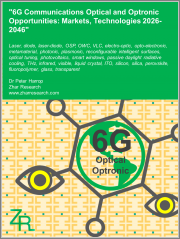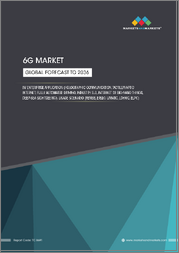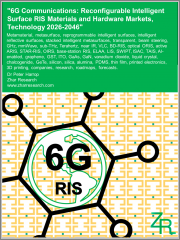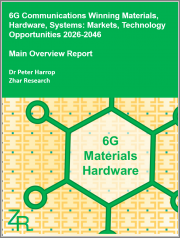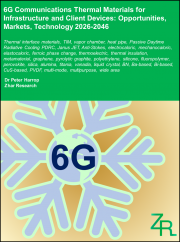
|
시장보고서
상품코드
1776774
6G 기술 시장 예측(-2032년) : 컴포넌트별, 네트워크 아키텍처별, 통신 인프라별, 주파수대별, 이용 시나리오별, 기술별, 용도별, 최종사용자별, 지역별 세계 분석6G Technology Market Forecasts to 2032 - Global Analysis By Component (Hardware, Software and Services), Network Architecture, Communication Infrastructure, Frequency Band, Usage Scenario, Technology, Application, End User and By Geography |
||||||
Stratistics MRC에 따르면 세계의 6G 기술 시장은 2025년에 1억 5,000만 달러를 차지하며 예측 기간 중 CAGR 성장률은 72.6%로, 2032년에는 70억 달러에 달할 것으로 예측됩니다.
6G 기술은 5G의 후속으로 구상되고 있는 6세대 무선통신 표준입니다. 네트워크 아키텍처의 도약을 의미하며, 테라헤르츠 대역과 같은 고급 주파수 스펙트럼의 사용, 스펙트럼 효율 향상, 최첨단 컴퓨팅 프레임워크와의 통합이 특징입니다. 하이퍼 커넥티드 생태계를 지원하기 위해 설계된 6G는 전 세계 통신 인프라 전반에 걸친 물리적 네트워크와 디지털 네트워크의 완벽한 융합을 통해 초고속 데이터 전송, 밀리초 이하의 지연 시간, 첨단 연결 기능을 목표로 하고 있습니다.
과학기술정보통신부에 따르면 한국 정부는 K-Network 2030 구상에 따라 5G 네트워크 상용화를 2년 앞당길 계획입니다.
저지연 네트워크에 대한 요구 증가
초저지연 네트워크에 대한 수요 증가는 6G 기술 시장의 주요 촉진요인입니다. 촉각 통신, 실시간 홀로그램 프로젝션, 자율주행차 제어와 같은 새로운 용도는 지연을 최소화한 거의 즉각적인 데이터 전송을 필요로 합니다. 현재의 5G 네트워크는 진보적이지만, 미래의 몰입형 경험과 미션 크리티컬한 운영에 대한 이러한 까다로운 지연 요건을 완전히 충족하지 못할 수 있습니다. 이 기본 능력은 업계 전체에 새로운 가능성을 열어줄 것이며, 저지연 성능은 차별화의 핵심이며, 6G 개발 시장 개발의 중요한 원동력이 될 것입니다.
제한된 세계 표준화
6G 기술 시장의 중요한 억제요인은 현재 세계 표준화가 보급되지 않았다는 점입니다. 새로운 무선 세대의 개발은 상호 운용성과 원활한 세계 연결을 보장하기 위해 기술 사양에 대한 광범위한 국제 협력과 합의가 필요합니다. 주파수 할당과 기술 프로토콜에 대한 국가별 접근 방식이 제각각인 경우, 광범위한 보급과 채택을 저해할 수 있습니다. 국제기구를 통해 공통의 프레임워크를 구축하는 것은 연구를 가속화하고, 상용화를 촉진하며, 응집력 있는 세계 6G 환경을 조성하는 데 있으며, 매우 중요합니다.
스마트 시티와 IoT 용도 확대
스마트 시티와 첨단 사물인터넷(IoT) 용도의 광범위한 확장은 5G 기술 시장에 큰 기회를 가져다 줄 것입니다. 스마트 시티는 실시간 데이터 수집과 지능형 도시 관리를 위해 상호 연결된 장치와 센서의 촘촘한 네트워크에 의존하고 있습니다. 비교할 수 없는 용량, 초저지연, 대규모 연결성을 갖춘 6G는 IoT 기기의 급격한 성장을 지원하고 정교한 스마트 시티 서비스를 구현하는 데 매우 중요합니다. 6G와 진화하는 스마트 시티 생태계와의 이러한 공생관계는 큰 시장 가능성을 창출합니다.
사이버 보안과 프라이버시 리스크
고도로 상호 연결된 6G 네트워크에 내재된 사이버 보안 및 프라이버시 위험은 시장 도입에 큰 위협이 될 수 있습니다. 수십억 개의 디바이스와 방대한 양의 기밀 데이터가 전례 없는 속도로 전송됨에 따라 사이버 위협의 공격 대상이 급격히 확대되고 있습니다. 첨단 사이버 공격, 데이터 유출, 프라이버시 침해의 가능성은 사회적 신뢰를 훼손하고 보급을 저해할 수 있습니다. 6G 시대에 만연한 이러한 위험을 줄이기 위해서는 견고하고 양자 내성이 강한 보안 프로토콜과 종합적인 프라이버시 규정의 개발이 필수적입니다.
COVID-19의 영향:
COVID-19 팬데믹은 견고하고 탄력적인 디지털 인프라에 대한 수요를 가속화시킴으로써 6G 기술 시장에 간접적인 영향을 미쳤습니다. 팬데믹 기간 중 원격 근무, 가상 커뮤니케이션, 디지털 서비스에 대한 의존도가 높아지면서 첨단 연결성의 중요성이 부각되었습니다. 6G는 아직 연구개발 초기 단계에 있지만, 팬데믹은 까다로운 용도를 지원하고 예기치 못한 사회적 도전에 대처할 수 있는 미래 지향적인 네트워크의 필요성을 강조했습니다. 장기적인 영향으로는 6G가 약속하는 기능 개발에 대한 인식 증가와 시급성을 꼽을 수 있습니다.
예측 기간 중 비지상파 네트워크(NTN) 분야가 가장 클 것으로 예측됩니다.
비지상파 네트워크(NTN) 부문은 기존 지상파 인프라를 넘어 6G 커버리지를 확장하는 데 중요한 역할을 할 것으로 예상되며, 예측 기간 중 가장 큰 시장 점유율을 차지할 것으로 예측됩니다. 위성 네트워크, 고고도 플랫폼 스테이션(HAPS), 무인항공기(UAV)를 포함한 NTN은 원격지, 해양, 영공에서 끊김 없는 연결성을 제공합니다. NTN은 내결함성이 뛰어나고 커버리지 갭을 메울 수 있으므로 미래의 6G 생태계에 필수적인 요소입니다. 광범위한 연결성을 제공하는 NTN은 전략적으로 중요하며, 시장 점유율이 큽니다.
예측 기간 중 테라헤르츠(300GHz 이상) 부문이 가장 높은 CAGR을 나타낼 것으로 예측됩니다.
예측 기간 중 테라헤르츠(300GHz 이상) 부문이 가장 높은 성장률을 보일 것으로 예측됩니다. 이는 6G의 전례 없는 대역폭과 데이터 전송률을 실현할 수 있는 엄청난 잠재력에 영향을 받았습니다. 테라헤르츠 주파수는 현재의 밀리미터파 대역에 비해 훨씬 더 넓은 주파수 자원을 제공하여 까다로운 용도를 위한 초고속 통신을 가능하게 합니다. 홀로그램 통신, 실시간 감지, AI 용도를 위한 대용량 데이터 전송을 지원하는 능력으로 테라헤르츠는 6G의 중요한 프론티어가 되어 시장 성장을 가속화할 것입니다.
최대 점유율 지역:
예측 기간 중 아시아태평양이 가장 큰 시장 점유율을 차지할 것으로 예측됩니다. 이는 통신 인프라 개발의 선도적 지위와 5G 및 미래 무선 기술에 대한 대규모 투자에 힘입은 바 큽니다. 중국, 한국, 일본 등 국가들은 막대한 정부 자금과 민간 부문의 참여로 6G 연구개발의 최전선에 서 있습니다. 이 지역은 인구 밀도가 높고 도시화가 빠르게 진행되고 있으며, 첨단 커넥티비티 솔루션에 대한 수요가 증가하고 있습니다. 또한 통신장비와 가전제품의 제조거점이 탄탄한 것도 이 지역이 6G의 전망을 형성하는 데 있으며, 지배적인 역할을 할 수 있는 요인 중 하나입니다.
CAGR이 가장 높은 지역:
예측 기간 중 북미가 가장 높은 CAGR을 보일 것으로 예측됩니다. 이는 탄탄한 연구개발 생태계, 강력한 산학협력, 차세대 무선기술에 대한 민간부문의 대규모 투자에 힘입은 바 큽니다. 이 지역의 주요 통신사 및 기술 대기업은 6G의 이용 사례와 기반 기술 탐색에 적극적으로 참여하고 있습니다. 또한 자율주행차, 확장현실(XR), 스마트 인프라 등의 분야에서 첨단 연결성에 대한 수요가 증가하고 있는 것도 북미 6G 시장의 급격한 성장을 촉진하고 있습니다.
무료 커스터마이징 제공:
이 보고서를 구독하는 고객은 다음과 같은 무료 맞춤화 옵션 중 하나를 이용할 수 있습니다.
- 기업소개
- 추가 시장 기업 종합 프로파일링(최대 3사)
- 주요 기업의 SWOT 분석(최대 3사)
- 지역 세분화
- 고객의 관심에 따른 주요 국가별 시장 추정, 예측, CAGR(주: 타당성 확인에 따라 다름)
- 경쟁사 벤치마킹
- 제품 포트폴리오, 지역적 입지, 전략적 제휴를 기반으로 한 주요 기업 벤치마킹
목차
제1장 개요
제2장 서문
- 개요
- 이해관계자
- 조사 범위
- 조사 방법
- 데이터 마이닝
- 데이터 분석
- 데이터 검증
- 조사 어프로치
- 조사 자료
- 1차 조사 자료
- 2차 조사 정보원
- 전제조건
제3장 시장 동향 분석
- 촉진요인
- 억제요인
- 기회
- 위협
- 기술 분석
- 용도 분석
- 최종사용자 분석
- 신흥 시장
- COVID-19의 영향
제4장 Porter's Five Forces 분석
- 공급 기업의 교섭력
- 바이어의 교섭력
- 대체품의 위협
- 신규 진출업체의 위협
- 경쟁 기업 간 경쟁 관계
제5장 세계의 6G 기술 시장 : 컴포넌트별
- 하드웨어
- 소프트웨어
- 서비스
제6장 세계의 6G 기술 시장 : 네트워크 아키텍처
- 무세포 Massive MIMO
- 분산형 인텔리전스 네트워크
- AI 네이티브 네트워크 설계
- 네트워크 슬라이싱 유효
- 오픈 RAN
제7장 세계의 6G 기술 시장 : 통신 인프라별
- 무선
- 모바일 셀룰러
- 모바일 브로드밴드
- 고정
제8장 세계의 6G 기술 시장 : 주파수대별
- 서브 테라헤르츠(서브 THz)(100-300GHz)
- 테라헤르츠(300GHz 이상)
제9장 세계의 6G 기술 시장 : 이용 시나리오별
- 한층 더 강화된 모바일 브로드밴드(FeMBB)
- 매우 신뢰성 높은 저지연 통신(ERLLC)
- 장거리·고이동성 통신(LDHMC)
- 초대형 규모 머신형 통신(umMTC)
- 극저전력 통신(ELPC)
제10장 세계의 6G 기술 시장 : 기술별
- 6G 코어 네트워크
- 비지상 네트워크(NTN)
- LEO 위성
- RIS
- 무세포 MIMO
- 양자 통신
- 기타 기술
제11장 세계의 6G 기술 시장 : 용도별
- 통신
- 헬스케어
- 운송
- 스마트 시티
- 기타 용도
제12장 세계의 6G 기술 시장 : 최종사용자별
- 제조업과 산업
- 농업과 스마트 농업
- 정부와 공공안전
- 미디어 & 엔터테인먼트
- 기타 최종사용자
제13장 세계의 6G 기술 시장 : 지역별
- 북미
- 미국
- 캐나다
- 멕시코
- 유럽
- 독일
- 영국
- 이탈리아
- 프랑스
- 스페인
- 기타 유럽
- 아시아태평양
- 일본
- 중국
- 인도
- 호주
- 뉴질랜드
- 한국
- 기타 아시아태평양
- 남미
- 아르헨티나
- 브라질
- 칠레
- 기타 남미
- 중동 및 아프리카
- 사우디아라비아
- 아랍에미리트
- 카타르
- 남아프리카공화국
- 기타 중동 및 아프리카
제14장 주요 발전
- 계약, 파트너십, 협업, 조인트 벤처
- 인수와 합병
- 신제품 발매
- 사업 확대
- 기타 주요 전략
제15장 기업 프로파일링
- AT&T
- NTT DoCoMo
- Orange
- Jio
- Vodafone Group
- Bharti Airtel
- SK Telecom
- Deutsche Telekom
- Verizon Communications
- China Mobile
- Telefonica S.A
- China Unicom
- Rakuten Mobile
- KT Corporation
- Singtel
- KDDI Corporation
According to Stratistics MRC, the Global 6G Technology Market is accounted for $0.15 billion in 2025 and is expected to reach $7.0 billion by 2032 growing at a CAGR of 72.6% during the forecast period. 6G Technology is the forthcoming sixth-generation standard for wireless communication, envisioned to succeed 5G. It represents a leap in network architecture, characterized by the use of advanced frequency spectrums such as terahertz bands, enhanced spectral efficiency, and integration with cutting-edge computing frameworks. Designed to support hyper-connected ecosystems, 6G aims for ultra-fast data transmission, sub-millisecond latency, and advanced connectivity capabilities through a seamless fusion of physical and digital networks across global communication infrastructures.
According to the Ministry of Science and ICT, the Korean government plans to expedite the commercial launch of the 6G network by two years under the K-Network 2030 initiative.
Market Dynamics:
Driver:
Growing need for low-latency networks
The escalating demand for ultra-low-latency networks is a primary driver for the 6G technology market. Emerging applications like haptic communication, real-time holographic projections, and autonomous vehicle control require virtually instantaneous data transmission with minimal delay. Current 5G networks, while advanced, may not fully meet these stringent latency requirements for future immersive experiences and mission-critical operations. This fundamental capability will unlock new possibilities across industries, making low-latency performance a core differentiator and key market impetus for 6G development.
Restraint:
Limited global standardization
A significant restraint for the 6G technology market is the current lack of widespread global standardization. The development of a new wireless generation requires extensive international collaboration and agreement on technical specifications to ensure interoperability and seamless global connectivity. Divergent national approaches to spectrum allocation and technological protocols could hinder widespread deployment and adoption. Establishing common frameworks through international bodies is crucial for accelerating research, facilitating commercialization, and fostering a cohesive global 6G landscape.
Opportunity:
Expansion of smart cities and IoT applications
The widespread expansion of smart cities and advanced Internet of Things (IoT) applications presents a vast opportunity for the 6G technology market. Smart cities rely on a dense network of interconnected devices and sensors for real-time data collection and intelligent urban management. 6G, with its unparalleled capacity, ultra-low latency, and massive connectivity, will be crucial for supporting the exponential growth of IoT devices and enabling sophisticated smart city services. This symbiotic relationship between 6G and the evolving smart city ecosystem creates significant market potential.
Threat:
Cybersecurity and privacy risks
The inherent cybersecurity and privacy risks associated with highly interconnected 6G networks pose a significant threat to market adoption. With billions of devices and vast amounts of sensitive data being transmitted at unprecedented speeds, the attack surface for cyber threats expands dramatically. The potential for sophisticated cyberattacks, data breaches, and privacy violations could erode public trust and deter widespread deployment. Developing robust, quantum-resistant security protocols and comprehensive privacy regulations will be essential to mitigate these pervasive risks in the 6G era.
Covid-19 Impact:
The COVID-19 pandemic indirectly influenced the 6G technology market by accelerating the demand for robust and resilient digital infrastructure. The increased reliance on remote work, virtual communication, and digital services during the pandemic highlighted the importance of advanced connectivity. While 6G is still in its nascent research and development phases, the pandemic underscored the need for future-proof networks capable of supporting highly demanding applications and addressing unforeseen societal challenges. The long-term impact is a heightened awareness and urgency for developing the capabilities that 6G promises to deliver.
The non-terrestrial networks (NTN) segment is expected to be the largest during the forecast period
The non-terrestrial networks (NTN) segment is expected to account for the largest market share during the forecast period, propelled by their crucial role in extending 6G coverage beyond traditional terrestrial infrastructure. NTNs, including satellite networks, high-altitude platform stations (HAPS), and unmanned aerial vehicles (UAVs), will provide seamless connectivity in remote areas, oceans, and airspace. The ability of NTNs to offer resilience and fill coverage gaps makes them an indispensable component of the future 6G ecosystem. Their strategic importance in providing pervasive connectivity drives their significant market share.
The terahertz (above 300 GHz) segment is expected to have the highest CAGR during the forecast period
Over the forecast period, the terahertz (above 300 GHz) segment is predicted to witness the highest growth rate, influenced by its immense potential to unlock unprecedented bandwidth and data rates for 6G. Terahertz frequencies offer significantly larger spectrum resources compared to current millimetres-wave bands, enabling ultra-fast communication for demanding applications. The ability to support holographic communication, real-time sensing, and massive data transfer for AI applications makes terahertz a critical frontier for 6G, driving its accelerated market growth.
Region with largest share:
During the forecast period, the Asia Pacific region is expected to hold the largest market share, fuelled by its leading position in telecommunications infrastructure development and extensive investments in 5G and future wireless technologies. Countries like China, South Korea, and Japan are at the forefront of 6G research and development, with significant government funding and private sector participation. The region's large population density and rapid urbanization drive the demand for advanced connectivity solutions. Furthermore, the strong manufacturing base for telecom equipment and consumer electronics contributes to the region's dominant role in shaping the 6G landscape.
Region with highest CAGR:
Over the forecast period, the North America region is anticipated to exhibit the highest CAGR, driven by its robust research and development ecosystem, strong academic-industrial collaborations, and significant private sector investments in next-generation wireless technologies. The region's leading telecommunications companies and technology giants are actively engaged in exploring 6G use cases and foundational technologies. Moreover, the increasing demand for advanced connectivity in sectors like autonomous vehicles, extended reality (XR), and smart infrastructure further propels North America's rapid expansion in the 6G market.
Key players in the market
Some of the key players in 6G Technology Market include AT&T, NTT DoCoMo, Orange, Jio, Vodafone Group, Bharti Airtel, SK Telecom, Deutsche Telekom, Verizon Communications, China Mobile, Telefonica S.A, China Unicom, Rakuten Mobile, KT Corporation, Singtel, and KDDI Corporation.
Key Developments:
In June 2025, AT&T announced a breakthrough in 6G network trials, achieving ultra-low latency of less than 1ms, paving the way for real-time holographic communications.
In May 2025, NTT DoCoMo unveiled its first commercial 6G prototype, focusing on terahertz frequency bands for ultra-high-speed data transmission.
In March 2025, China Mobile demonstrated the world's first 6G-enabled smart city pilot project, integrating IoT and AI for autonomous urban management.
Components Covered:
- Hardware
- Software
- Services
Network Architectures Covered:
- Cell-Free Massive MIMO
- Distributed Intelligence Networks
- AI-Native Network Design
- Network Slicing Enabled
- Open RAN
Communication Infrastructures Covered:
- Wireless
- Fixed
Frequency Bands Covered:
- Sub-Terahertz (sub-THz) (100-300 GHz)
- Terahertz (above 300 GHz)
Usage Scenarios Covered:
- Further-Enhanced Mobile Broadband (FeMBB)
- Extremely Reliable, Low Latency Communications (ERLLC)
- Long-Distance & High-Mobility Communications (LDHMC)
- Ultra-Massive Machine Type Communications (umMTC)
- Extremely Low-Power Communications (ELPC)
Technologies Covered:
- 6G Core Network
- Non-Terrestrial Networks (NTN)
- LEO Satellites
- RIS
- Cell-Free MIMO
- Quantum Communication
- Other Technologies
Applications Covered:
- Telecommunications
- Healthcare
- Transportation
- Smart Cities
- Other Applications
End Users Covered:
- Manufacturing & Industrial
- Agriculture & Smart Farming
- Government & Public Safety
- Media & Entertainment
- Other End Users
Regions Covered:
- North America
- US
- Canada
- Mexico
- Europe
- Germany
- UK
- Italy
- France
- Spain
- Rest of Europe
- Asia Pacific
- Japan
- China
- India
- Australia
- New Zealand
- South Korea
- Rest of Asia Pacific
- South America
- Argentina
- Brazil
- Chile
- Rest of South America
- Middle East & Africa
- Saudi Arabia
- UAE
- Qatar
- South Africa
- Rest of Middle East & Africa
What our report offers:
- Market share assessments for the regional and country-level segments
- Strategic recommendations for the new entrants
- Covers Market data for the years 2024, 2025, 2026, 2028, and 2032
- Market Trends (Drivers, Constraints, Opportunities, Threats, Challenges, Investment Opportunities, and recommendations)
- Strategic recommendations in key business segments based on the market estimations
- Competitive landscaping mapping the key common trends
- Company profiling with detailed strategies, financials, and recent developments
- Supply chain trends mapping the latest technological advancements
Free Customization Offerings:
All the customers of this report will be entitled to receive one of the following free customization options:
- Company Profiling
- Comprehensive profiling of additional market players (up to 3)
- SWOT Analysis of key players (up to 3)
- Regional Segmentation
- Market estimations, Forecasts and CAGR of any prominent country as per the client's interest (Note: Depends on feasibility check)
- Competitive Benchmarking
- Benchmarking of key players based on product portfolio, geographical presence, and strategic alliances
Table of Contents
1 Executive Summary
2 Preface
- 2.1 Abstract
- 2.2 Stake Holders
- 2.3 Research Scope
- 2.4 Research Methodology
- 2.4.1 Data Mining
- 2.4.2 Data Analysis
- 2.4.3 Data Validation
- 2.4.4 Research Approach
- 2.5 Research Sources
- 2.5.1 Primary Research Sources
- 2.5.2 Secondary Research Sources
- 2.5.3 Assumptions
3 Market Trend Analysis
- 3.1 Introduction
- 3.2 Drivers
- 3.3 Restraints
- 3.4 Opportunities
- 3.5 Threats
- 3.6 Technology Analysis
- 3.7 Application Analysis
- 3.8 End User Analysis
- 3.9 Emerging Markets
- 3.10 Impact of Covid-19
4 Porters Five Force Analysis
- 4.1 Bargaining power of suppliers
- 4.2 Bargaining power of buyers
- 4.3 Threat of substitutes
- 4.4 Threat of new entrants
- 4.5 Competitive rivalry
5 Global 6G Technology Market, By Component
- 5.1 Introduction
- 5.2 Hardware
- 5.3 Software
- 5.4 Services
6 Global 6G Technology Market, By Network Architecture
- 6.1 Introduction
- 6.2 Cell-Free Massive MIMO
- 6.3 Distributed Intelligence Networks
- 6.4 AI-Native Network Design
- 6.5 Network Slicing Enabled
- 6.6 Open RAN
7 Global 6G Technology Market, By Communication Infrastructure
- 7.1 Introduction
- 7.2 Wireless
- 7.2.1 Mobile Cellular
- 7.2.2 Mobile Broadband
- 7.3 Fixed
8 Global 6G Technology Market, By Frequency Band
- 8.1 Introduction
- 8.2 Sub-Terahertz (sub-THz) (100-300 GHz)
- 8.3 Terahertz (above 300 GHz)
9 Global 6G Technology Market, By Usage Scenario
- 9.1 Introduction
- 9.2 Further-Enhanced Mobile Broadband (FeMBB)
- 9.3 Extremely Reliable, Low Latency Communications (ERLLC)
- 9.4 Long-Distance & High-Mobility Communications (LDHMC)
- 9.5 Ultra-Massive Machine Type Communications (umMTC)
- 9.6 Extremely Low-Power Communications (ELPC)
10 Global 6G Technology Market, By Technology
- 10.1 Introduction
- 10.2 6G Core Network
- 10.3 Non-Terrestrial Networks (NTN)
- 10.4 LEO Satellites
- 10.5 RIS
- 10.6 Cell-Free MIMO
- 10.7 Quantum Communication
- 10.8 Other Technologies
11 Global 6G Technology Market, By Application
- 11.1 Introduction
- 11.2 Telecommunications
- 11.3 Healthcare
- 11.4 Transportation
- 11.5 Smart Cities
- 11.6 Other Applications
12 Global 6G Technology Market, By End User
- 12.1 Introduction
- 12.2 Manufacturing & Industrial
- 12.3 Agriculture & Smart Farming
- 12.4 Government & Public Safety
- 12.5 Media & Entertainment
- 12.6 Other End Users
13 Global 6G Technology Market, By Geography
- 13.1 Introduction
- 13.2 North America
- 13.2.1 US
- 13.2.2 Canada
- 13.2.3 Mexico
- 13.3 Europe
- 13.3.1 Germany
- 13.3.2 UK
- 13.3.3 Italy
- 13.3.4 France
- 13.3.5 Spain
- 13.3.6 Rest of Europe
- 13.4 Asia Pacific
- 13.4.1 Japan
- 13.4.2 China
- 13.4.3 India
- 13.4.4 Australia
- 13.4.5 New Zealand
- 13.4.6 South Korea
- 13.4.7 Rest of Asia Pacific
- 13.5 South America
- 13.5.1 Argentina
- 13.5.2 Brazil
- 13.5.3 Chile
- 13.5.4 Rest of South America
- 13.6 Middle East & Africa
- 13.6.1 Saudi Arabia
- 13.6.2 UAE
- 13.6.3 Qatar
- 13.6.4 South Africa
- 13.6.5 Rest of Middle East & Africa
14 Key Developments
- 14.1 Agreements, Partnerships, Collaborations and Joint Ventures
- 14.2 Acquisitions & Mergers
- 14.3 New Product Launch
- 14.4 Expansions
- 14.5 Other Key Strategies
15 Company Profiling
- 15.1 AT&T
- 15.2 NTT DoCoMo
- 15.3 Orange
- 15.4 Jio
- 15.5 Vodafone Group
- 15.6 Bharti Airtel
- 15.7 SK Telecom
- 15.8 Deutsche Telekom
- 15.9 Verizon Communications
- 15.10 China Mobile
- 15.11 Telefonica S.A
- 15.12 China Unicom
- 15.13 Rakuten Mobile
- 15.14 KT Corporation
- 15.15 Singtel
- 15.16 KDDI Corporation






